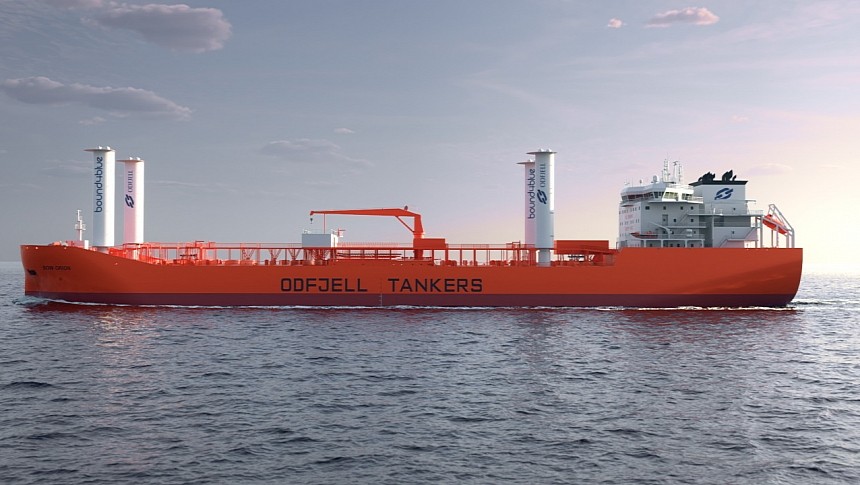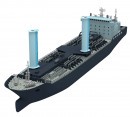Someone once described wind power as the cleanest energy source in the world. Today's world can benefit from the powerful pairing of this universal energy source with state-of-the-art technology, resulting in unprecedented efficiency. One of these innovative approaches to wind-assisted propulsion is called suction sail and will be installed on a tanker for the first time ever.
Two big players in the maritime industry have joined forces for a project that could change tanker operations forever. Odjfell, a Norwegian shipping company, has selected the eSail suction sail system developed by the Spanish tech company bound4blue to be installed on its fleet. At first, the eSail system will be fitted on a chemical tanker, which will make it the first tanker in the global industry to feature this innovative technology.
The Norwegian giant chose eSail after a complex evaluation of existing wind-assisted propulsion systems (WAPS) completed by SSPA. The technology developed by bound4blue promises to produce up to seven times more lift than a conventional sail while also requiring minimal fuel consumption and simple mechanical tasks.
According to the designer, eSail uses suction based on "active boundary layer control." It goes on to explain that when suction is activated, the small amount of air that gets sucked in adheres to the airflow to the sail. This translates to a powerful lift combined with low drag.
Here are some of the advantages of this technology: it works 100% autonomously; it's small and lightweight, with no impact on the vessel's cargo capacity; it's easy to integrate on both current fleets and future vessels; it requires almost no maintenance at all; most importantly, it claims to be affordable and highly-efficient, with huge fuel savings and significantly lower emission levels.
The bound4blue sailing system has already proven its efficiency on other types of ships, but this is the first time it will be installed on a tanker, more specifically, a chemical tanker. This industry-first installation is due to be completed next year when it will pave the way for other tanks as well.
Like other players in the industry, the Norwegian shipping company is on a journey towards cleaner operations that will comply with the increasingly harsher maritime regulations. So far, it has improved its carbon intensity by more than 50% compared to 2008 levels.
Wind-assisted propulsion is slowly but surely changing the way we do shipping. There are many routes leading to greener maritime transportation, and harnessing the power of wind is considered one of the most efficient.
Airseas, the maritime branch of Airbus, launched the futuristic Seawing, a system that combines kite technology with automated flight control derived from aerospace. More recently, Michelin also started testing its innovative sailing system, called Wisamo, on a commercial ship.
The Norwegian giant chose eSail after a complex evaluation of existing wind-assisted propulsion systems (WAPS) completed by SSPA. The technology developed by bound4blue promises to produce up to seven times more lift than a conventional sail while also requiring minimal fuel consumption and simple mechanical tasks.
According to the designer, eSail uses suction based on "active boundary layer control." It goes on to explain that when suction is activated, the small amount of air that gets sucked in adheres to the airflow to the sail. This translates to a powerful lift combined with low drag.
Here are some of the advantages of this technology: it works 100% autonomously; it's small and lightweight, with no impact on the vessel's cargo capacity; it's easy to integrate on both current fleets and future vessels; it requires almost no maintenance at all; most importantly, it claims to be affordable and highly-efficient, with huge fuel savings and significantly lower emission levels.
The bound4blue sailing system has already proven its efficiency on other types of ships, but this is the first time it will be installed on a tanker, more specifically, a chemical tanker. This industry-first installation is due to be completed next year when it will pave the way for other tanks as well.
Like other players in the industry, the Norwegian shipping company is on a journey towards cleaner operations that will comply with the increasingly harsher maritime regulations. So far, it has improved its carbon intensity by more than 50% compared to 2008 levels.
Wind-assisted propulsion is slowly but surely changing the way we do shipping. There are many routes leading to greener maritime transportation, and harnessing the power of wind is considered one of the most efficient.
Airseas, the maritime branch of Airbus, launched the futuristic Seawing, a system that combines kite technology with automated flight control derived from aerospace. More recently, Michelin also started testing its innovative sailing system, called Wisamo, on a commercial ship.







